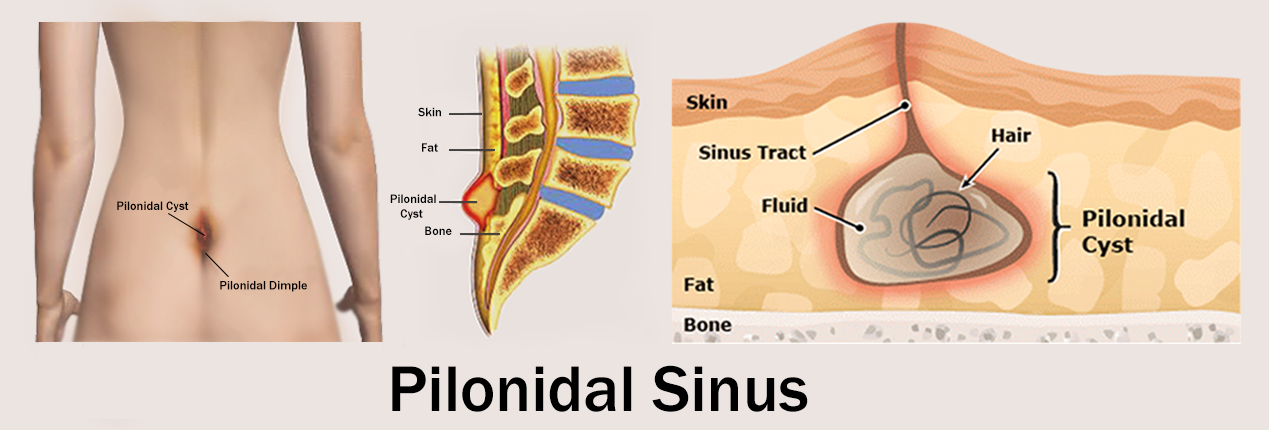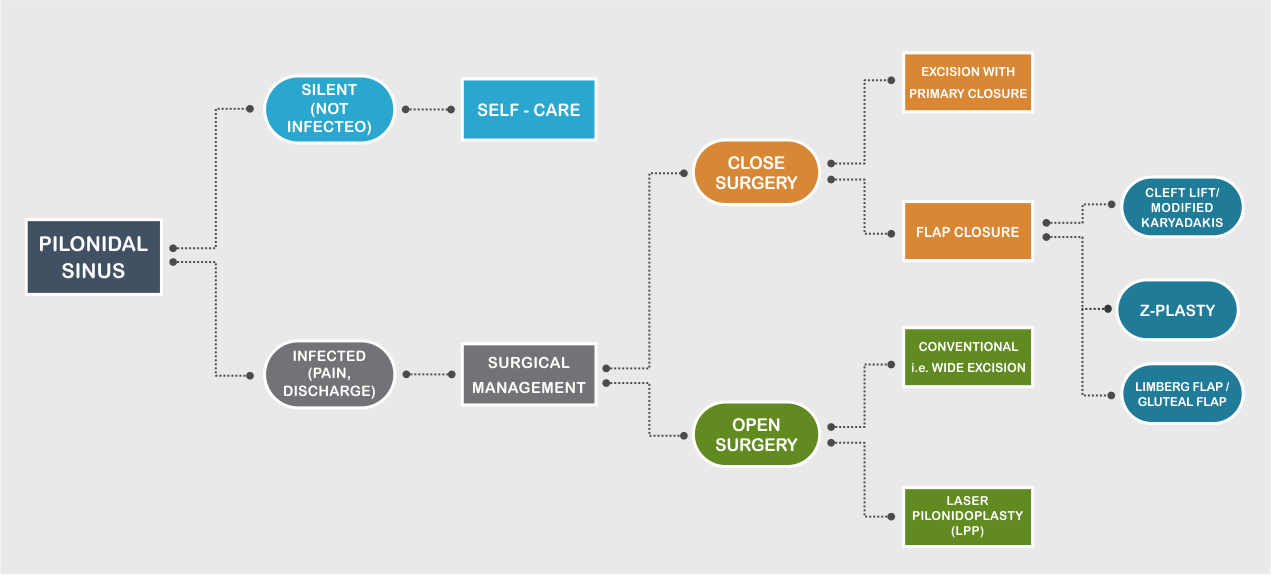- About Us
- Facilities
- Patient Stories
- Media & Events
- CSR
- Contact Us
- Book Appointment
A Pilonidal sinus also called Pilonidal cyst, Pilonidal abcess or Sacrococcygeal fistula is a cyst ( small sac ) or tunnel in the skin. It develops over the tailbone at the top of the cleft of the buttocks. The cyst usually contains hair and skin debris. More than one cyst may develop and these are linked by tunnels under the skin.

No treatment is necessary in case of a Pilonidal sinus that lies dormant, which means it is not infected. In this silent phase, certain precautions are advised which may abate the chances of infection and thereby, the need for a surgery.
Following care should be taken :
If there is pain or discharge from the Pilonidal sinus, it spells infection and surgery is likely to be needed.

In this procedure the surgeon does a wide bore local excision of the skin containing the sinus tract. The resulting cavity is left open to heal and fill in naturally from the bottom upwards. The wound is kept covered with a dressing.
The disadvantage of wide excision is that the wound size is large and healing may take upto 3 months. The dressing needs to be changed daily making it a tedious process. However the procedure is safe with a recurrence rate of 10-15%.
This is a minimally invasive procedure done using the Leonardo laser. This laser was first introduced in India at Healing Hands Clinic. In LPP, a small cut is made on the skin and all the pus is drained out. The entire sinus tract is then sealed with the laser fibre.
In this procedure, the abscess and sinus are surgically removed and the wound is closed with stitches/sutures. The stitch line is preferably off the midline, where the tension is less and chances of healing are better.
The advantage of this technique is that the healing is faster and takes about 4-6 weeks. The main drawback is that the infection rate is almost 20-25%. In case of such an infection a revision procedure is done and the wound is left for open healing anyways.
In Z-plasty after removing the abscess and sinus, the surgeon loosens triangular flaps on each side of the midline to fill the cavity, with points of flap towards the head and foot. While closing the surgeon crosses the pointed flaps to cross the midline in a horizontal direction, thus converting an N-shaped incision to a Z-shaped closure.
Z-plasty is not a preferred choice of treatment because :
In this procedure the surgeon removes all the area of disease and makes sure the wound is healthy. The resultant defect, a football shaped 'ellipse' or cavity, lies parallel to the midline but to one side. The edges of the skin are then freed up a little and the wound is closed with multi-layered stitches. In cleft lift, the actual shape of the cleft is changed to be more shallow and allow for better healing. By almost flattening the cleft, the gathering of loose hair is less likely, and the less deep cleft does not favour the growth of anaerobic bacteria.
This procedure is done in patients who have extensive Pilonidal disease or who have disease affecting both sides of the buttock. The surgeon removes an oblong shaped plug containing the abscess, skin and fat, thus creating a cavity. To fill the cavity, a flap of skin and thick fat is mobilised from the buttock beside and below the cavity. The flap is swung into the centre and the edges are sutured.
NOTE : The flap procedures are quite invasive and patients are hospitalised for a couple of days afterwards. The post-operative recovery time is also quite long. These surgeries remove a large amount of tissue, which destabilises the area and leave few options to the patient if they fail.
A history of your symptoms followed by a visual examination of the tailbone area is enough to diagnose a Pilonidal sinus.
Pilonidal sinus can be a tricky condition. It is of utmost importance that you understand it well, as self care is an important aspect, especially if you have been operated upon. Following are answers to a few questions that may arise in your mind before you decide to undergo a surgery. These are general guidelines and any final decision about your health lies with your surgeon.
Pilonidal sinus or pilonidal cyst contains hair and skin debris. It may lead to infection under the skin and surgery is recommended in that case. It is not a serious or dangerous problem
If pilonidal sinus is not infected then surgical treatment is not required. Certain precautions can be followed at home for its healing. These precautions include:
If there is pus discharge from the cyst then surgery is recommended.
Pilonidal sinus or cyst occurs due to thick body hair especially those that are coarse and curly. It is mostly common in males but females can also face this problem.
LPP ( Laser Pilonidoplasty ) is an Advanced Laser Procedure for Pilonidal Sinus. The main advantage of LPP is faster recovery with negligible pain and recurrence rate
Pilonidal sinus is both curable as well as preventable. If the cyst is infected then it can be cured through advanced laser procedure.
Most of the surgeries for Pilonidal sinus are done under General anaesthesia. So apart from a pin-prick there is not much you will feel. After that it's just like going into deep sleep.
Soon after your operation you may feel some discomfort and pain as the effect of the anaesthetic medicine wears off. However, painkillers should solve your problem. You can start having sips of water after a couple of hours, and an hour thereafter, a regular full diet can be started
You can start walking the same day. There need not be any change in your toilet patterns. You will probably need time off work, although this depends on how you are feeling and the type of work you do. After a laser surgery you can join office work from 3rd day. If you have undergone a flap surgery or have stitches, you can join office after 2 weeks. In any case, strenuous work should be avoided for the first 2 weeksYou can start mild to moderate exercise as soon as you feel able to. However, if you have stitches, you will have to avoid activities that disrupt the stitches for upto 4 weeks
Whichever the type of operation you have ( open/close ), it is extremely important to keep the site of wound clean. We will direct you on how to do this, which may include the following guidelines:
Following your operation you may need help if you have :
As the cause of Pilonidal sinus is excessive thick hair that breaks and gets embedded into the skin, the problem of recurrence is always looming large. The recurrence can be prevented to a large extent by using temporary methods like razors, hair removal creams etc. However, it is extremely bothersome for the patients to do this regularly, that too at a rather inaccessible area of the body. Thus, permanent hair reduction with Lasers ( Diode, Nd-YAG ) is advised to reduce hair growth and hair thickness in the area.